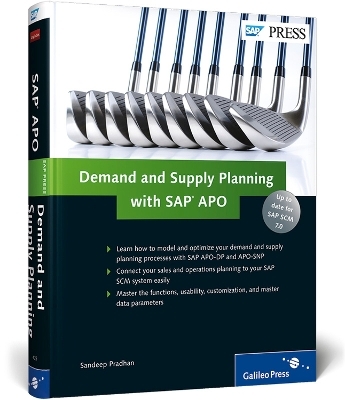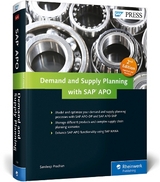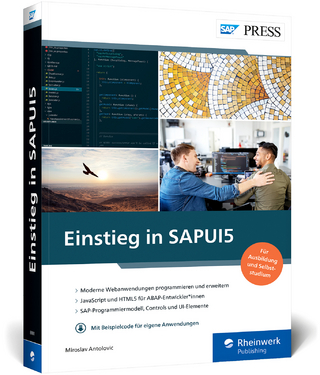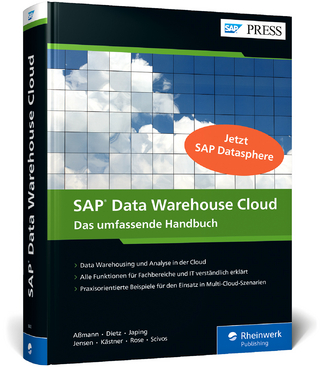
Demand and Supply Planning with SAP APO
SAP Press (Verlag)
978-1-59229-423-7 (ISBN)
- Titel ist leider vergriffen;
keine Neuauflage - Artikel merken
Components and Modules Understand how the APO-DP and SNP functionalities work in SAP APO, as well as with other SAP functions and systems such as SAP NetWeaver BW, SAP CRM, and SAP ERP. Tracking Needs and Success Learn what SAP APO tools you need to meet your demand and supply planning business requirements, and then use different tools to monitor your efforts. ABC Technology Follow a fictional business and understand how to translate its business requirements into technical processes.
Sandeep Pradhan is an SAP solution architect in the supply chain management field and has more than 17 years of professional experience. He specializes in supply chain application advisory services and has achieved results by helping clients understand, architect, select, and implement the SAP supply chain solutions required to run their businesses. In his various roles (project manager, solution architect, functional consultant, supply chain manager), he has been responsible for providing thought leadership in supply chain strategy, business processes transformation, technology architecture, and business integration. He has worked on numerous full lifecycle SAP APO-Demand Planning and Supply Network Planning implementations from the discovery phase through the implementation phase. Sandeep holds an MBA from Monash University, Australia, and is also author of the book Implementing and Configuring SAP Event Management (SAP PRESS, 2010) and co-author of Global Available-to-Promise with SAP: Functionality and Configuration (SAP PRESS, 2011).
Introduction. 21
1. Introduction to Supply Chain Planning. 27
1.1. Sales and Operations Planning. 30
1.2. Supply Chain Operations Reference Model. 36
1.3. Types of Supply Chains. 48
1.4. Case Study: A Supply Chain Dilemma. 49
1.5. Demand and Supply Planning Overview. 57
1.6. Summary. 74
2. Introduction to SAP APO as an Advanced Planning and Scheduling (APS) Tool. 75
2.1. Advanced Planning and Scheduling Concepts. 76
2.2. Introduction to SAP Advanced Planning & Optimization. 82
2.3. SAP APO Planning Functions. 91
2.4. SAP APO Demand Planning Overview. 95
2.5. SAP APO Supply Network Planning Overview. 101
2.6. SAP APO Technical Architecture. 107
2.7. SAP liveCache Technology. 108
2.8. Summary. 110
3. SAP APO Implementation Guidelines. 111
3.1. Supply Chain Planning Transformation Initiatives and Prerequisites. 112
3.2. SAP APO Implementation Methodology. 117
3.3. SAP APO Template Rollout Approach. 120
3.4. Change Management. 123
3.5. Incorporating Performance Measures in SAP APO Projects. 126
3.6. Business Benefits Realization. 128
3.7. Business Case Study. 136
3.8. Summary. 147
4. Preparing for Basic Planning Functionality in SAP APO. 149
4.1. Basic Planning Tasks. 150
4.2. Basic Customization in SAP APO Demand Planning. 155
4.3. Data Staging for SAP APO Demand Planning. 182
4.4. Data Management in SAP APO Demand Planning. 190
4.5. Setting up Forecast Methods. 193
4.6. Basic Customization in SAP APO Supply Network Planning. 209
4.7. Supply Chain Modeling for SAP APO Supply Network Planning. 225
4.8. Summary. 244
5. Basic Interactive Planning in SAP APO. 245
5.1. Demand and Supply Planning Cycle. 246
5.2. Interactive Demand Planning. 249
5.3. Interactive Statistical Forecasting. 267
5.4. Interactive Supply Planning. 270
5.5. SNP Heuristics. 273
5.6. Load Planning Using the SNP Transport Load Builder. 288
5.7. Demand and Supply Planning Alerts. 293
5.8. Simulation via Version Management. 297
5.9. Summary. 299
6. Advanced Demand Planning Concepts in SAP APO. 301
6.1. Promotion Planning. 302
6.2. Lifecycle Planning. 310
6.3. Seasonal Planning. 315
6.4. SAP APO Demand Planning Bill of Material Functionality. 319
6.5. Customer and Product Segmentation. 326
6.6. Customer Forecast Management. 328
6.7. SAP APO Demand Planning Alerts. 330
6.8. Duet Demand Planning. 331
6.9. Summary. 333
7. Advanced Supply Planning Concepts in SAP APO. 335
7.1. Safety Stock Planning. 336
7.2. Aggregated Planning. 347
7.3. Shelf Life Planning. 360
7.4. Planning Strategies and Forecast Consumption. 371
7.5. Subcontracting. 377
7.6. Warehouse Capacity Overview. 383
7.7. Direct Shipment Customers. 385
7.8. Product Interchangeability in APO-SNP. 388
7.9. Transport Load Builder. 397
7.10. Stock Balancing. 405
7.11. Supply Planning Alerts. 408
7.12. Supply Chain Cockpit. 416
7.13. Summary. 417
8. Collaborative Planning with SAP APO. 419
8.1. Collaborative Planning Overview. 420
8.2. Collaborative Demand Planning. 423
8.3. Collaborative Supply Planning. 426
8.4. Collaborative Planning Workflow. 428
8.5. Collaborative Planning Configuration Steps. 429
8.6. Vendor Managed Inventory. 437
8.7. Integrating SAP Supply Network Collaboration with SAP APO: Overview. 443
8.8. Inter-Market Demand and Supply Planning in the Same Advanced Planning and Optimization Application Instance. 447
8.9. Summary. 452
9. Demand and Supply Planning Reporting. 453
9.1. SAP Supply Chain Performance Management Overview. 454
9.2. SAP APO and SAP NetWeaver BW Integration. 457
9.3. Extraction Process from SAP APO liveCache to SAP NetWeaver BW. 465
9.4. Demand Planning Data Model. 472
9.5. SAP APO Supply Network Planning Data Model. 476
9.6. SAP NetWeaver BW Business Content. 477
9.7. Summary. 486
10. SNP Optimizer. 487
10.1. SNP Optimization Concept. 488
10.2. SNP Optimizer Costs. 493
10.3. Profiles Used by the SNP Optimizer. 502
10.4. Case Study Scenario: Network Model. 504
10.5. SNP Optimizer: Automatic Cost Model. 516
10.6. SNP Optimization Explanation Log. 520
10.7. Case Study Scenario: Supply Allocations. 521
10.8. SNP Deployment Optimizer. 530
10.9. The APO Performance Monitor. 532
10.10. Integration of External Optimizers to SAP APO. 533
10.11. Summary. 535
11. Demand and Supply Matching with Capable-To-Match. 537
11.1. Capable-to-Match Concept. 538
11.2. CTM Customization. 543
11.3. CTM Master Data. 557
11.4. CTM Planning Run. 558
11.5. CTM Case Study. 560
11.6. Summary. 562
12. Inventory Planning and Optimization with SAP APO and SAP ERP. 563
12.1. Inventory Optimization. 565
12.2. Inventory Analysis Methodology. 571
12.3. Designing an Inventory Control System. 590
12.4. Multi-Echelon Inventory Planning. 601
12.5. Summary. 605
13. Characteristics-Based Planning in SAP APO. 607
13.1. Characteristics-Based Planning Process Overview. 608
13.2. Characteristics-Based Planning Technical Steps. 610
13.3. Characteristics-Based Forecasting. 624
13.4. Supply Planning Integration. 634
13.5. Summary. 639
14. SAP Industry Solution Example with SAP APO. 641
14.1. SAP Apparel and Footwear (AFS) Industry Solution. 642
14.2. SAP ERP (AFS Extension): Integrated Solution Overview. 644
14.3. Master and Transactional Data Integration. 649
14.4. SAP APO Solution for AFS Using Aggregated Functionality. 657
14.5. SAP Business Function. 663
14.6. Summary. 664
15. Technical Concepts in SAP APO. 665
15.1. APO Core Interface. 666
15.2. SAP APO Technical Upgrade: Functional Activities. 702
15.3. SAP APO Authorization Concept. 709
15.4. SAP APO Process Chain. 712
15.5. Hardware Sizing using Quick Sizer. 718
15.6. Technical Integration with Non-SAP Applications. 722
15.7. Summary. 725
16. Data Conversion and Technical Enhancements. 727
16.1. Data Conversion Strategy for SAP APO. 728
16.2. Introduction to the Legacy System Migration Workbench (LSMW). 732
16.3. SAP APO Data Conversion Using LSMW. 733
16.4. Technical Enhancements in SAP APO. 745
16.5. Summary. 761
17. Conclusions and Outlook. 763
Appendices. 767
A. Resources. 769
B. List of Acronyms. 771
C. The Author. 777
Index. 779
| Erscheint lt. Verlag | 31.12.2012 |
|---|---|
| Reihe/Serie | SAP PRESS Englisch |
| Verlagsort | Maryland |
| Sprache | englisch |
| Maße | 175 x 228 mm |
| Themenwelt | Mathematik / Informatik ► Informatik ► Netzwerke |
| Informatik ► Weitere Themen ► SAP | |
| ISBN-10 | 1-59229-423-5 / 1592294235 |
| ISBN-13 | 978-1-59229-423-7 / 9781592294237 |
| Zustand | Neuware |
| Haben Sie eine Frage zum Produkt? |
aus dem Bereich



